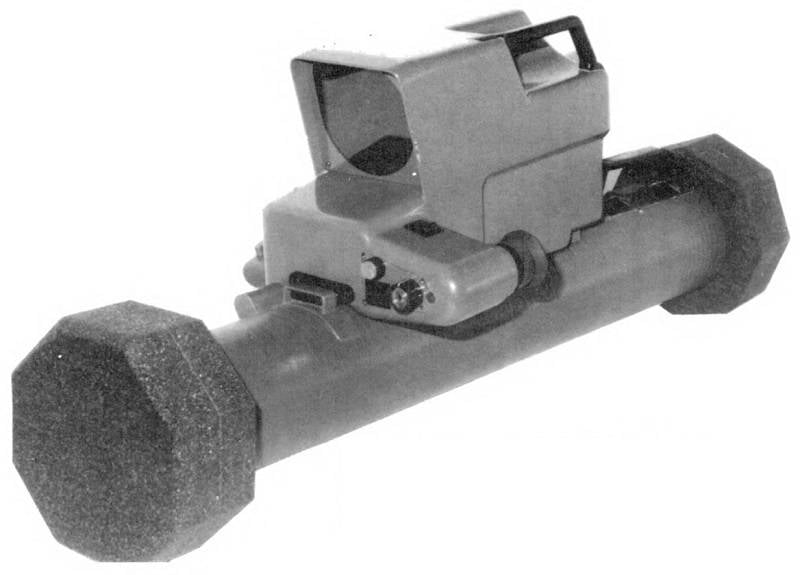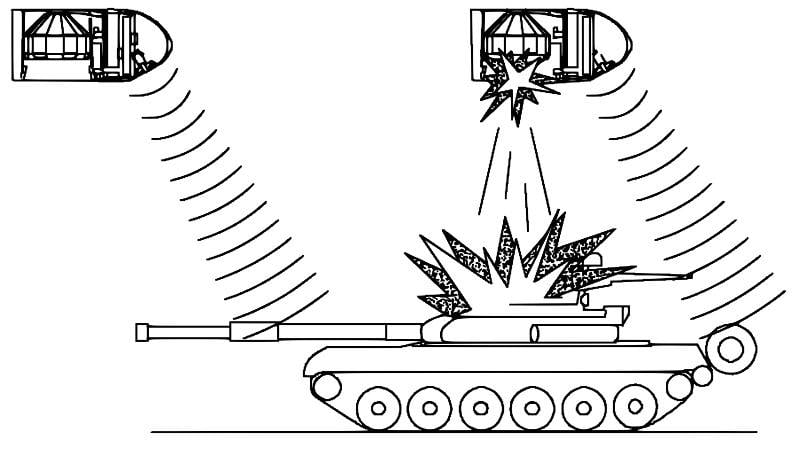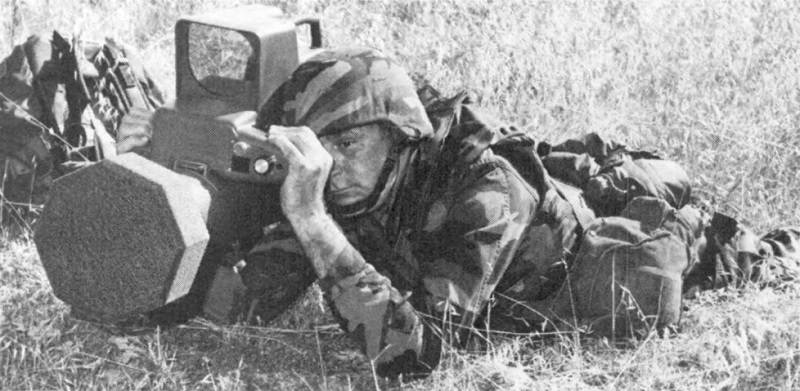ATGM "Topkik": anti-aircraft complex against tanks

Is it possible to remake weapon, created to combat air targets, into an effective anti-tank weapon? Of course, it is possible, and the German 88-mm and 128-mm guns used by the German army during the Second World War to fight armored vehicles can be an example of this. But this is cannon artillery, but what about missiles? Experts from the American company Ford Aerospace were able to answer this question.
Advanced Antitank Weapon System
In the mid-80s of the last century, the large-scale Advanced Antitank Weapon System (AAWS) competitive program was gaining momentum in the United States, within the framework of which work was underway to create new anti-tank weapons for the marines and ground units. Many of the largest representatives of the aerospace, rocket, electronic and metallurgical industries of the country applied for participation as performers. The firm whose project won the selection received a solid jackpot in the form of a large state order.
To eliminate bureaucratic delays and possible difficulties with funding, AAWS was divided into two independent subprograms. The first involved the development of heavy wearable, self-propelled and aviation missile systems, and the second - light infantry systems, the brainchild of which later became Topkik.
The general requirements for light anti-tank systems were not particularly distinguished by some kind of exclusivity and, on the whole, were standard:
– effective destruction of modern Soviet tanks with dynamic protection at distances from several tens of meters to two or three kilometers;
- the ability to fire from small rooms;
- the minimum time spent by the shooter in position after the shot, in order to exclude him from falling under the enemy's retaliatory strike;
- if possible, the maximum exclusion of the influence of the human factor (pointing errors) on the accuracy of shooting;
- packing all this into a complex with low weight and dimensions and a calculation of one or two people.
In accordance with the conditions put forward, the companies that took part in the tender demonstrated several projects.
Texas Instruments and Raytheon, with their contractors, showed broadly similar systems under the names TI-AAWS-M and Stryker. Their missiles were equipped with infrared homing heads and had two flight path options: horizontal and "slide" with an attack on the tank's most vulnerable spot - the roof. The abundance of electronics used in these products minimized the actions of the operators in preparing for the shot: it was enough to capture the target in the sight and launch, and then immediately go into cover or continue shelling other objects.
Hughes Aircraft went the other way and put up for the FOG-M ATGM competition with manual control by wire. Its feature was a television camera built into the rocket, which made it possible to significantly increase the range of fire and improve its accuracy.
But at Ford Aerospace they had a different vision of the current situation and dumped on the table ... an anti-aircraft missile system converted for anti-tank needs.
From "Alternative to Stinger" to anti-tank missile
History The emergence of Topkik has its roots in the mid-70s, when the US Army was faced with the issue of replacing the existing Redai man-portable anti-aircraft missile systems with more advanced ones. The priority was the Stinger, which had already passed all the necessary tests, but the leadership of Ford Aerospace managed to agree with the government and the military on the development of its own missile system, which, if it does not become the basis of low-level air defense, will at least complement it. Even the name spoke for itself - "Alternative to Stinger".
The main difference between the Ford engineers' idea was the manual guidance of an anti-aircraft missile along a laser beam, that is, the shooter literally had to keep the aiming mark on a target moving in the sky, thereby highlighting it. This method, oddly enough, did not have any outstanding advantages, or very frank shortcomings: thermal homing heads at that time could not yet boast of a stable capture of fired objects, but the sight and the Alternativa laser system had good stabilizers, so no accidental movement could derail the process.

ATGM "Alternative to Stinger"
Structurally, the “Stinger Alternative” was designed in the form of a disposable launch tube that joined each other, which served as a unitary shot, and a control unit. The rocket included a steering module with a computer system, a solid propellant engine and a fragmentation warhead with a proximity fuse. The control unit consisted of electronic elements, an optical sight and two laser emitters associated with it, a removable battery and a stabilization system. After pressing the trigger, the rocket flew out of the launch tube under the action of a pushing engine and, switching to a marching engine, rushed to the target at a speed of about 600 meters per second, guided by a laser beam. Thus, it was possible to effectively deal with helicopters and subsonic aircraft at an altitude of 2-3 kilometers.

Anti-aircraft missile complex from the company "Ford"
By 1975, MANPADS had passed some tests, but hopes were not destined to come true. The military eventually abandoned the development of the Ford, so the project was forgotten for a while.
In the early 80s, the Stinger Alternative was again remembered. At that time, another campaign for the development of missile weapons was taking place in the United States, so the Ford Aerospace company revived its offspring and carried out a rather deep modernization of it. First of all, the changes affected the electronic component: new night vision devices, improved laser emitters and computer systems were introduced. Also, the rocket received an enlarged warhead with a shaped-charge fragmentation charge - you can highlight not only an air target, but also a tank, so the possibility of fighting ground equipment was not ruled out. The updated complex received a new name "Saber" (SABER) and was proposed for release in portable and self-propelled versions. But here, too, failure awaited him - the customers were never found.

Components of the upgraded Saber missile
"Topkick"
In 1986, the qualifying round of the very Advanced Antitank Weapon System program began. The prize for the winner was very significant: an order for 7 launchers and about 70 missiles, and then, as is usually the case, contracts for maintenance, modernization and replenishment of ammunition. In addition, part of the cost of developing and testing systems was borne by the state. The leadership of Ford Aerospace did not refuse such a chance and announced its Saber for the competition, which had to be brought to the required condition in anti-tank defense and renamed Topkick.
The first changes affected the appearance. Based on the requirements of the military, the ATGM had to have high ergonomic characteristics, so the launch tube was replaced with a lightweight one made of composite materials. The sight with a day and night channel, combined with a laser emitter, was moved to the top of the control unit, leaving the eyepiece on the left side for the operator. Also, the former anti-aircraft complex got rid of all additional external power sources.
As for the emitter mentioned above, it was also decided to change its basis: for shooting at ground vehicles, powerful long-range illumination that breaks through clouds is not needed and even harms due to increased battery discharge. As a result, Ford Aerospace turned to its competitors Hughes Aircraft, who were able to supply them with lightweight lasers.

ATGM "Topkik"
Perhaps the main change in Topkick was the new ammunition load. The previously available cumulative-fragmentation ammunition, in principle, made it possible to fight tanks that were not the first freshness and without dynamic protection, but they could no longer meet the new standards. The new guided missiles that replaced them were equipped with a perpendicularly located rotary tandem shaped charge with a penetration of 700–750 mm behind dynamic protection and a non-contact radar fuse. The attack was carried out according to the traditional scenario - into the roof.

The principle of operation of a non-contact radar fuse
The work of the complex, which changed air targets to ground targets, was as follows. The shooter needed to dock the control unit with a disposable shot-pipe and, holding the sight on the enemy tank, pull the trigger. Still guided by the laser beam that illuminated the target, the rocket rushed forward, passing all the way above the line of sight. The non-contact fuse worked in two stages. At first, when the rocket was just starting to fly over the tank, the rocket's onboard system signaled to turn the shaped charge down. Then, being above the geometric center of the machine, the sensor undermined the charge.
ATGM "Topkik" met almost all the wishes of the military:
- effectively fought with any modern tanks with dynamic protection at a distance of more than 2 km;
- worked according to the principle: “thrown it on my shoulder, pointed and fired”, which, coupled with the supersonic speed of the rocket, often made it possible to hit the tank in less time than it took just the acquisition of a target from complexes with a homing head;
- provided the possibility of firing from small rooms due to the pushing low-smoke engine, which he inherited from the Stinger Alternative;
- by weight it fit within 20 kilograms, so it could be used by one person;
- was not susceptible to most interference in the form of various kinds of masking aerosols and heat traps;
– was much cheaper than competitors.

A shortened version of the "Topkick" for shooting from a prone position
There were, of course, some disadvantages, including: less than that of homing missiles, the probability of hitting equipment from the first shot, the need to guide the missile until it hit the target or miss, and a proximity fuse, which still did not have sufficient reliability. These factors largely predetermined the result of comparative tests of anti-tank systems in 1988. In them, Topkick took the place of a solid middle peasant, losing to the undisputed leader - the TI-AAWS-M project.
In fairness, greed and conservatism won out in the competition: the military nevertheless chose the path of least resistance and decided to modernize the Dragon, which was already in service. As for Texas Instruments, which owned the TI-AAWS-M, they had to overcome a long journey, full of bureaucratic and financial adventures, to bring their development to mass production and put it into service with the US Army under the name "Javelin".
Information